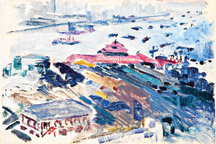Before the “drip” paintings of Pollock and the “multiform” style of Rothko, there was Weehawken’s own John Marin, credited as the father of American abstractionism for his treatment of oils like watercolors and his forays into abstraction.
Though a Weehawken legacy himself, Marin actually left a tangible legacy behind for his native land – a 100-oil sketch series of the town and its views, collectively known as “The Weehawken Sequence.”
An exhibit, featuring 32 of the 100 sketches, will be on display in Manhattan at Meredith Ward Fine Art, 44 E. 74th St., Ste. 1 through March 12. Visitors must call ahead of time at (212) 744-7305.
John Marin’s “The Weehawken Sequence” will be on display through March 12 at Meredith Ward Fine Art.
________
The beginning of abstract
John Marin (1870-1953) contentiously holds the title of the first American artists to make abstract paintings. Some people offer names like Marsden Hartley and Georgia O’Keeffe, but it’s widely been recognized that Marin got there first.
Though born a few miles away in Rutherford, Marin actually grew up in Weehawken and attended the Stevens Institute of Technology in Hoboken for a year – early residences to which art experts attribute the architectural themes in his later paintings and watercolors.
After studying at the Pennsylvania Academy of Fine Arts in Philadelphia and the Arts Students League of New York, he travelled throughout Europe for six years before returning to the United States and his native Weehawken, from which sprang the inspiration for “The Weehawken Sequence.”
On display
From now until March 12, some sketches from Marin’s largely un-exhibited “The Weehawken Sequence” will be on exhibit at Meredith Ward Fine Art in Manhattan.
Marin began the 100-oil sketch series in 1910 after returning from Europe, and worked for six years depicting scenes in and around his hometown.
His sketches evoke a strong sense of energy and dynamism, and focus on the imagery of elevators and railroad tracks, the Palisades, and some of Weehawken’s most effervescent views: the Hudson River and the New York City skyline. They blend aspects of Impressionism, Fauvism, and Cubism.
Of the 100 sketches in the series, 32 of them have been drawn from his estate to be put on display until next week.
Thus, if one goes with the commonly accepted notion of Marin as the father of the county’s abstract movement, Weehawken may have been one of the earliest places in the country to be documented in abstract form.
Precedent-setting in Weehawken
While working on “The Weehawken Sequence,” Marin found a strong support system in Hoboken-born modern art promoter Alfred Stieglitz, who showed Marin’s work almost every year in one of his galleries.
Aside from inspiration deriving from Weehawken and New York City, Marin set up his wares in Maine – a favorite destination for him for its rocky coastline, not unlike that of Weehawken.
His work reached new artistic heights in the 1920s as he delved further into the abstract medium. He also painted new landscapes in New Mexico.
But Marin couldn’t stay away from his two loves – New Jersey and Maine – and returned to the East Coast in the 1930s. The next two decades are considered the time when he produced influential oils that impacted the next generation of Abstract Expressionist artists.
Marin’s paintings can be found in many important collections and museums nearby, including: the Metropolitan Museum of Art, the Museum of Modern Art, the Whitney Museum of American Art, and the Brooklyn Museum, among others place in the country.
Deanna Cullen can be reached at dcullen@hudsonreporter.com.
